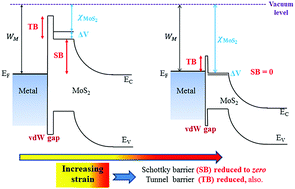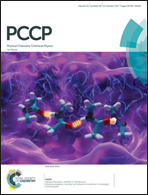A new insight for ohmic contacts to MoS2: by tuning MoS2 affinity energies but not metal work-functions†
Abstract
Two-dimensional (2D) transition metal dichalcogenides (TMDCs) have recently attracted tremendous interest for fundamental studies and applications. High contact resistances between the metal electrodes and the 2D TMDCs, usually composed of a tunneling barrier (TB) and a Schottky barrier (SB), are the key bottleneck to the realization of high performance devices based on such systems. Here, from van der Waals density functional theory calculations, we demonstrate that strain can provide a feasible means to reduce the contact resistances between, for example, 2D semiconductor MoS2 and metal surfaces, in both strong and weak coupling regimes. Both the SB and TB are lowered significantly with the increasing tensile strain in both the coupling regimes. Especially, the SB can reduce to zero in all configurations considered, with tensile strain increasing to ∼4% or above. The mechanism of SB reduction under tensile strain is attributed to the increase of the MoS2 affinity energy since the monolayer MoS2 conduction band minimum (CBm) is derived from anti-bonding states. Thus, the SB in other semiconducting TMDCs with an anti-bonding CBm (for n-type contact) could also be reduced to zero by tensile strain. Our discoveries thus shed a new and general light on minimizing the contact resistance of semiconducting TMDCs–metal based contacts and this can also prove applicable to other 2D semiconductors, e.g. phosphorene.



 Please wait while we load your content...
Please wait while we load your content...